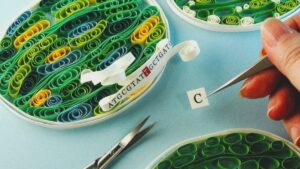Genome editing is a promising new technique for plant breeding. With designer nucleases called meganucleases, zinc finger nucleases, and TALENs, mutations can be precisely directed to any gene of interest. CRISPR-Cas9 is the latest innovation, as it can easily be ‘programmed’ by a separate guide RNA and is currently the chief genome editing tool used.
The nucleases only create a DNA break at the desired location in the genome, which is subsequently repaired by the cell’s DNA repair mechanism. The mode of repair used by the cell determines the outcome of the reparation. DNA repair following non-homologous end joining (NHEJ) (which simply joins the ends of the broken DNA together) is relatively error-prone and may result in small errors (small deletions or insertions) at the location of the repaired DNA break. Homology-directed repair (HDR) uses a repair template (for example the homologous chromosome, or one that is supplied during the experiment) for accurate, error-free repair. In plants NHEJ is the predominant repair mechanism.
Loss-of-Gene-Function Mutations
Deletions induced by CRISPR-Cas followed by NHEJ-repair may cause a reading frame shift. This often leads to premature stop codons in the coding sequence of a gene, causing loss of gene function. Almost all publications about genome editing in plants so far describe the induction and selection of plants with such loss-of-function mutations. These studies have resulted in a substantial series of plants with novel traits. For example, mutation of disease susceptibility genes (S-genes) has resulted in powdery mildew resistance in bread wheat, in a broad potyvirus resistance in cucumber, while rice was made resistant to certain pathotypes of bacterial leaf blight. Deletion of genes involved in starch biosynthesis produced high amylopectin (“waxy”) maize and potato varieties. High oleic acid oilseed crops soybean and Camelina were made by knockouts in genes involved in further steps in the fatty acid biosynthesis.

Improved Gene Function
So, switching off gene functions may create improved varieties, but even more is possible by improving the function of already existing genes. Using CRISPR-Cas and a repair template containing a superior allele of the targeted gene could result in plants with improved gene functions. The reason why few publications report on allele replacements is the extremely low frequency of HDR (DNA repair using a template) in plants. Tricks such as co-inserting selection markers (e.g. herbicide resistance genes) together with the new allele enable positive selection for HDR events, but this gives end products containing additional undesirable genes. Undoubtedly, various future improvements of the methods used will enable allele replacement without leaving behind ‘foreign DNA’. In 2016 DuPont Pioneer already reported on using CRISPR-Cas9 and repair by HDR in maize for replacing the promoter region of the ARGOS8 ethylene sensitivity gene by a promoter from a different maize gene, without inserting other DNA sequences. The resulting plants did not slow down growth upon drought during flowering and early seed set, which resulted in increased grain yield in the field under mild drought conditions.
Genome Editing is Not Easy
An important reason why researchers succeeded in the application of HDR for replacement of promoter sequences in maize was the availability of extremely optimized methods for maize plant transformation. In addition, the simple genetics (diploid) and the availability of a high-quality genomic DNA sequence also contributed to the success of gene editing experiments in maize. It is clear that (optimal) transformation methods, simple genetics and genome information are lacking for many small crops, including many horticultural species.

Just to illustrate what challenges one may encounter when performing genome editing in a small crop, we sketch the effort needed for a genome editing project in chrysanthemum, a hexaploid ornamental, aimed at knocking out a single gene function. Since no genome sequence exists, our starting point was the available transcriptomic sequence data. We amplified the genomic DNA sequence corresponding to the short coding sequence of our target gene, but it turned out to include many introns, adding up to 6 kb extra. Moreover we discovered that there were two paralogous genes, which implied that in a hexaploid species in total 2×6=12 alleles needed to be deleted to achieve a complete knock-out of the gene function. Then, our regeneration and transformation experiments showed that only a few cultivars are amenable to efficient regeneration and transformation. This makes clear that genome editing is not yet a generally easy applicable mutation technology, as is often suggested.
Other Issues to Consider
To achieve targeted mutations by CRISPR-Cas, the nuclease system has to be delivered into the plant cell. Straightforward methods stably introduce the gene constructs for CRISPR-Cas and its accompanying guide RNA(s) into the plant’s genome, and after the intended mutations have been induced, the CRISPR-Cas genes are removed, for example by crossing and selecting null-segregants that inherit the induced mutation, but not the construct. Crossing is not suitable for heterozygous crops, diploid or polyploid, in which varieties are vegetatively propagated or that have a long generation time. As a solution, methods for transient expression of the CRISPR-Cas9 machinery have been developed and several publications show that plants with the intended mutations can be recovered without presence of the nuclease constructs.
For instance, isolated potato leaf protoplasts were treated with TALENs constructs that targeted an invertase gene. Mutant potato plants were created that did not produce reduced sugars during cold storage. The technology for recovery of plants from protoplasts is however only available for a handful of crops. A focus towards transient expression and regeneration of edited plants from other plant tissues is certainly required.
Conclusion
Although genome editing using programmable nucleases is recognized as a revolution in plant breeding, there are still several technical hurdles to take. The quick succession of nucleases and improvements of methods indicates that over time genome editing may evolve into a generally applied technology. We did not touch upon consumer acceptance and legal status of products produced by genome editing, but these should certainly be taken into account when it comes to marketing of commercial gene edited products.
—Jan Schaart is scientific researcher and Rene Smulders is business unit manager at Wageningen UR Plant Breeding in The Netherlands













